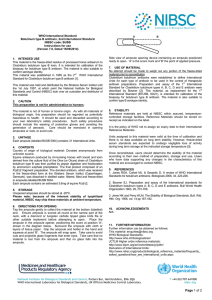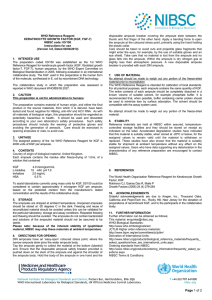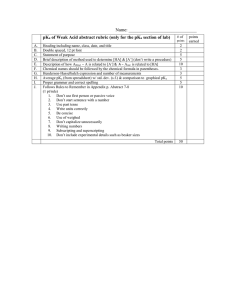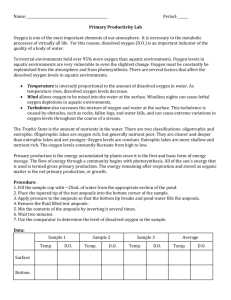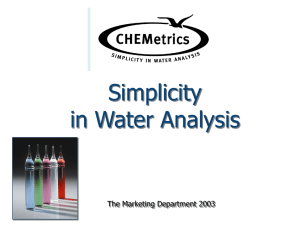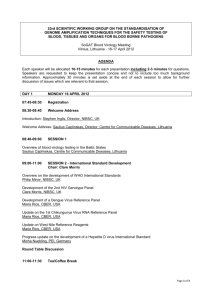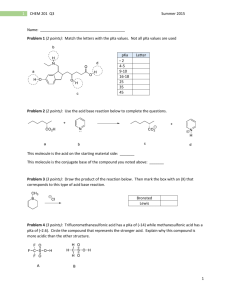2nd International Standard For Prekallikrein Activator
advertisement
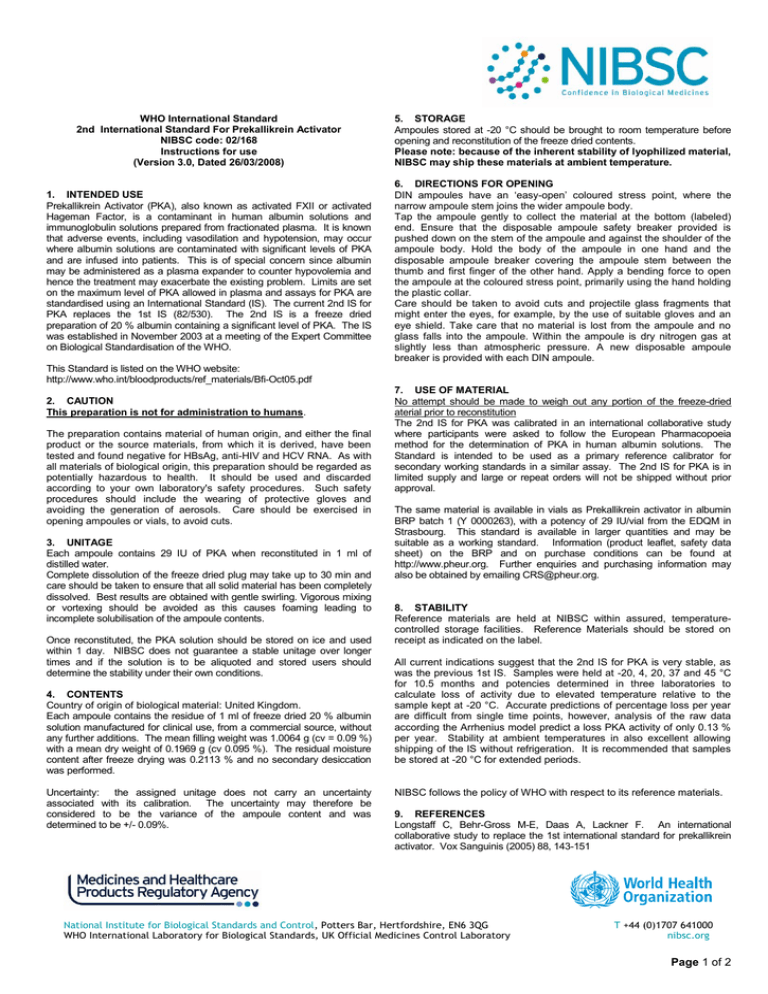
WHO International Standard 2nd International Standard For Prekallikrein Activator NIBSC code: 02/168 Instructions for use (Version 3.0, Dated 26/03/2008) 5. STORAGE Ampoules stored at -20 °C should be brought to room temperature before opening and reconstitution of the freeze dried contents. Please note: because of the inherent stability of lyophilized material, NIBSC may ship these materials at ambient temperature. 1. INTENDED USE Prekallikrein Activator (PKA), also known as activated FXII or activated Hageman Factor, is a contaminant in human albumin solutions and immunoglobulin solutions prepared from fractionated plasma. It is known that adverse events, including vasodilation and hypotension, may occur where albumin solutions are contaminated with significant levels of PKA and are infused into patients. This is of special concern since albumin may be administered as a plasma expander to counter hypovolemia and hence the treatment may exacerbate the existing problem. Limits are set on the maximum level of PKA allowed in plasma and assays for PKA are standardised using an International Standard (IS). The current 2nd IS for PKA replaces the 1st IS (82/530). The 2nd IS is a freeze dried preparation of 20 % albumin containing a significant level of PKA. The IS was established in November 2003 at a meeting of the Expert Committee on Biological Standardisation of the WHO. 6. DIRECTIONS FOR OPENING DIN ampoules have an „easy-open‟ coloured stress point, where the narrow ampoule stem joins the wider ampoule body. Tap the ampoule gently to collect the material at the bottom (labeled) end. Ensure that the disposable ampoule safety breaker provided is pushed down on the stem of the ampoule and against the shoulder of the ampoule body. Hold the body of the ampoule in one hand and the disposable ampoule breaker covering the ampoule stem between the thumb and first finger of the other hand. Apply a bending force to open the ampoule at the coloured stress point, primarily using the hand holding the plastic collar. Care should be taken to avoid cuts and projectile glass fragments that might enter the eyes, for example, by the use of suitable gloves and an eye shield. Take care that no material is lost from the ampoule and no glass falls into the ampoule. Within the ampoule is dry nitrogen gas at slightly less than atmospheric pressure. A new disposable ampoule breaker is provided with each DIN ampoule. This Standard is listed on the WHO website: http://www.who.int/bloodproducts/ref_materials/Bfi-Oct05.pdf 2. CAUTION This preparation is not for administration to humans. The preparation contains material of human origin, and either the final product or the source materials, from which it is derived, have been tested and found negative for HBsAg, anti-HIV and HCV RNA. As with all materials of biological origin, this preparation should be regarded as potentially hazardous to health. It should be used and discarded according to your own laboratory's safety procedures. Such safety procedures should include the wearing of protective gloves and avoiding the generation of aerosols. Care should be exercised in opening ampoules or vials, to avoid cuts. 3. UNITAGE Each ampoule contains 29 IU of PKA when reconstituted in 1 ml of distilled water. Complete dissolution of the freeze dried plug may take up to 30 min and care should be taken to ensure that all solid material has been completely dissolved. Best results are obtained with gentle swirling. Vigorous mixing or vortexing should be avoided as this causes foaming leading to incomplete solubilisation of the ampoule contents. Once reconstituted, the PKA solution should be stored on ice and used within 1 day. NIBSC does not guarantee a stable unitage over longer times and if the solution is to be aliquoted and stored users should determine the stability under their own conditions. 4. CONTENTS Country of origin of biological material: United Kingdom. Each ampoule contains the residue of 1 ml of freeze dried 20 % albumin solution manufactured for clinical use, from a commercial source, without any further additions. The mean filling weight was 1.0064 g (cv = 0.09 %) with a mean dry weight of 0.1969 g (cv 0.095 %). The residual moisture content after freeze drying was 0.2113 % and no secondary desiccation was performed. Uncertainty: the assigned unitage does not carry an uncertainty associated with its calibration. The uncertainty may therefore be considered to be the variance of the ampoule content and was determined to be +/- 0.09%. 7. USE OF MATERIAL No attempt should be made to weigh out any portion of the freeze-dried aterial prior to reconstitution The 2nd IS for PKA was calibrated in an international collaborative study where participants were asked to follow the European Pharmacopoeia method for the determination of PKA in human albumin solutions. The Standard is intended to be used as a primary reference calibrator for secondary working standards in a similar assay. The 2nd IS for PKA is in limited supply and large or repeat orders will not be shipped without prior approval. The same material is available in vials as Prekallikrein activator in albumin BRP batch 1 (Y 0000263), with a potency of 29 IU/vial from the EDQM in Strasbourg. This standard is available in larger quantities and may be suitable as a working standard. Information (product leaflet, safety data sheet) on the BRP and on purchase conditions can be found at http://www.pheur.org. Further enquiries and purchasing information may also be obtained by emailing CRS@pheur.org. 8. STABILITY Reference materials are held at NIBSC within assured, temperaturecontrolled storage facilities. Reference Materials should be stored on receipt as indicated on the label. All current indications suggest that the 2nd IS for PKA is very stable, as was the previous 1st IS. Samples were held at -20, 4, 20, 37 and 45 °C for 10.5 months and potencies determined in three laboratories to calculate loss of activity due to elevated temperature relative to the sample kept at -20 °C. Accurate predictions of percentage loss per year are difficult from single time points, however, analysis of the raw data according the Arrhenius model predict a loss PKA activity of only 0.13 % per year. Stability at ambient temperatures in also excellent allowing shipping of the IS without refrigeration. It is recommended that samples be stored at -20 °C for extended periods. NIBSC follows the policy of WHO with respect to its reference materials. 9. REFERENCES Longstaff C, Behr-Gross M-E, Daas A, Lackner F. An international collaborative study to replace the 1st international standard for prekallikrein activator. Vox Sanguinis (2005) 88, 143-151 National Institute for Biological Standards and Control, Potters Bar, Hertfordshire, EN6 3QG WHO International Laboratory for Biological Standards, UK Official Medicines Control Laboratory T +44 (0)1707 641000 nibsc.org Page 1 of 2 Longstaff C, Behr-Grosse M-E, Daas A, Lackner F. Collaborative Study to Establish a new Biological Reference Preparation for Prekallikrein Activator. Pharmeuropa-Bio, 2005-1, 1-11, 2005 10. ACKNOWLEDGEMENTS 11. FURTHER INFORMATION Further information can be obtained as follows; This material: enquiries@nibsc.org WHO Biological Standards: http://www.who.int/biologicals/en/ JCTLM Higher order reference materials: http://www.bipm.org/en/committees/jc/jctlm/ Derivation of International Units: http://www.nibsc.org/products/biological_reference_materials/frequentl y_asked_questions/how_are_international_units.aspx Ordering standards from NIBSC: http://www.nibsc.org/products/ordering_information/frequently_asked_ questions.aspx NIBSC Terms & Conditions: http://www.nibsc.org/terms_and_conditions.aspx 12. CUSTOMER FEEDBACK Customers are encouraged to provide feedback on the suitability or use of the material provided or other aspects of our service. Please send any comments to enquiries@nibsc.org 13. CITATION In all publications, including data sheets, in which this material is referenced, it is important that the preparation's title, its status, the NIBSC code number, and the name and address of NIBSC are cited and cited correctly. 14. MATERIAL SAFETY SHEET Physical and Chemical properties Physical Corrosive: No appearance: Freeze dried powder Stable: Oxidising: No Yes Hygroscopic: Irritant: No No Flammable: Handling: See caution, Section 2 No Other (specify): Contains material of human origin Action on Spillage and Method of Disposal Spillage of ampoule contents should be taken up with absorbent material wetted with an appropriate disinfectant. Rinse area with an appropriate disinfectant followed by water. Absorbent materials used to treat spillage should be treated as biological waste. 15. LIABILITY AND LOSS In the event that this document is translated into another language, the English language version shall prevail in the event of any inconsistencies between the documents. Unless expressly stated otherwise by NIBSC, NIBSC‟s Standard Terms and Conditions for the Supply of Materials (available at http://www.nibsc.org/About_Us/Terms_and_Conditions.aspx or upon request by the Recipient) (“Conditions”) apply to the exclusion of all other terms and are hereby incorporated into this document by reference. The Recipient's attention is drawn in particular to the provisions of clause 11 of the Conditions. 16. INFORMATION FOR CUSTOMS USE ONLY Country of origin for customs purposes*: United Kingdom * Defined as the country where the goods have been produced and/or sufficiently processed to be classed as originating from the country of supply, for example a change of state such as freeze-drying. Net weight: 10mg Toxicity Statement: Toxicity not assessed Veterinary certificate or other statement if applicable. Attached: No 17. CERTIFICATE OF ANALYSIS NIBSC does not provide a Certificate of Analysis for WHO Biological Reference Materials because they are internationally recognised primary reference materials fully described in the instructions for use. The reference materials are established according to the WHO Recommendations for the preparation, characterization and establishment of international and other biological reference standards http://www.who.int/bloodproducts/publications/TRS932Annex2_Inter_biol efstandardsrev2004.pdf (revised 2004). They are officially endorsed by the WHO Expert Committee on Biological Standardization (ECBS) based on the report of the international collaborative study which established their suitability for the intended use. Toxicological properties Effects of inhalation: Not established, avoid inhalation Effects of ingestion: Not established, avoid ingestion Effects of skin absorption: Not established, avoid contact with skin Suggested First Aid Inhalation: Seek medical advice Ingestion: Seek medical advice Contact with eyes: Wash with copious amounts of water. Seek medical advice Contact with skin: Wash thoroughly with water. National Institute for Biological Standards and Control, Potters Bar, Hertfordshire, EN6 3QG WHO International Laboratory for Biological Standards, UK Official Medicines Control Laboratory T +44 (0)1707 641000 nibsc.org Page 2 of 2
